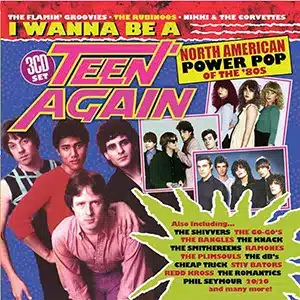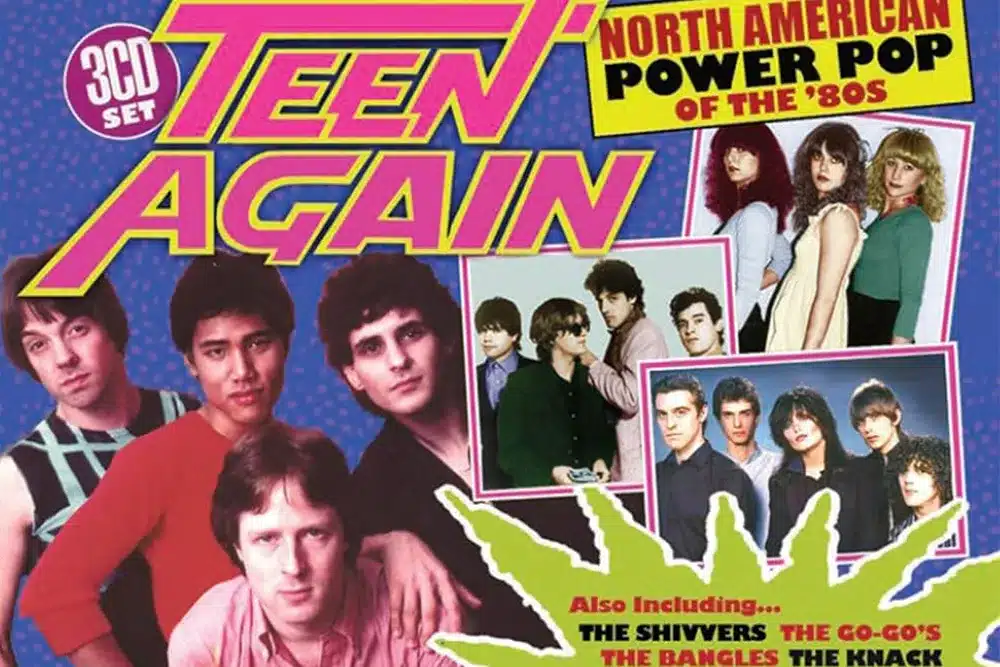
Power pop was always music for other musicians to like, or for people whose record collections eclipsed their social lives. The songs were catchy and poppy.
 I Wanna Be a Teen Again: North American Power Pop of the ’80s Various Artists Cherry Red 18 July 2025
I Wanna Be a Teen Again: North American Power Pop of the ’80s Various Artists Cherry Red 18 July 2025
Cherry Red Records are no strangers to this type of niche genre-specific, deep-dive collections. It’s surprising, then, that they’ve gotten the cover art for I Wanna Be a Teen Again so wrong. It is meant to recall 1980s teen idol magazines like Teen Beat, and it flat-out swipes the look of one called Teen Machine. It’s garish, but that’s not the real problem. More crucially, despite the collection’s title, the artwork is simply off-base.
The subtitle of I Wanna Be a Teen Again explains it all: North American Power Pop of the ’80s. No fewer than 78 artists and bands are represented here, but how many of them ever came close to being teen idols? Rick Springfield, for sure. A lot of people got hot and bothered over Robin Zander from Cheap Trick, that’s true. Eric Carmen?

The fact is, not many of these artists were ever popular enough to feature on the cover of anything other than their records and maybe a fanzine like Bomp!, which also became a seminal label in what is referred to as power pop. Power pop, though, for the most part, was always music for other musicians to like, or for people whose record collections eclipsed their social lives. Even the term “power pop” seems inaccurate now. The songs were catchy and poppy, but also guitar-based in a way that contemporary pop music hasn’t been in decades. “Power rock” or, as one band proclaimed, “strum and drum” would be more appropriate.
A more accurate description for North American power pop would be “music made by Anglophiles”. In a cultural/historical context, power pop was a curious phenomenon, notable as much for what it was not as for what it was. I Wanna Be a Teen Again is virtually unaffected by disco or the burgeoning dance and rap music scenes of the time. There aren’t many synthesizers to be heard, either.
Early punk music was something of a paradox because culturally it was progressive and aspired to revolution, but musically its guitar-bass-drums axis and short, sharp arrangements were reactionary. The power pop on I Wanna Be a Teen Again is firmly rooted in 1950s and 1960s rockabilly and Merseybeat, the British Invasion, the Beach Boys, and Phil Spector, but it doesn’t bother with the shaved hair, ripped clothing, or safety pins. Looking back, you could say power pop was not so much a reaction to the Beatles‘ split as it was to their adoption of psychedelia, studio effects, and tape loops.
As such, the 78 tracks here are more stylistically consistent and more uniform than those of a lot of other genres. The alternately chugging and jangling guitars, big chords, sweet melodies, and rapid-fire drum beats are all here, and they are bountiful. Some of the names are well-known to more casual 1980s fans: Cheap Trick, the Go-Gos, and the Bangles all had mainstream success. Cheap Trick’s rapturous “If You Want My Love”, a minor hit at the time, remains an underappreciated high point of the entire style, though another airing of Springfield’s “Jessie’s Girl” seems gratuitous.
Another trove of names will be familiar to those with a cursory knowledge of power pop and/or early alternative music. The Ramones‘ buzzing “My Kind of Girl”, the Flamin’ Groovies’ “Please Please Me” update “So Much In Love”, and the Knack‘s punchy “Want Ya” are worthwhile chances to go beyond those groups’ signature songs. Dwight Twilley, Marshall Crenshaw, and Tommy Keene are power pop royalty, and they are well-represented with cracking tunes.
However, it’s some of the rarer, more obscure, and curious material that yields true gems and makes I Wanna Be a Teen Again worth the investment of time and money. Screen Test’s “Nothing Really Matters When You’re Young” adds a taste of ska and phasing effects. Shoes’ “She Satisfies” juxtaposes heavy metal riffage with whimsical keyboards, while cuts from the Michael Guthrie Band and Windbreakers bring the jangle for shoulda-been-hits.
Along the way are surprise appearances from people who were or would be connected with everyone from Jefferson Airplane and the Beach Boys to Blondie and Lords of the New Church. It seems that the refined, no-frills traits of power pop really did appeal to all sorts—except mainstream radio programmers and their audiences. Actually, on the last third of I Wanna Be a Teen Again, anodyne, digitally-enhanced 1980s production begins to replace this purity with vapidity—a malaise Velvet Crush’s vibrant closer “Walking Out on Love” tries its best to remedy.
The legacy of power pop is challenging to pinpoint. Surely, one can hear its effect on the likes of British indie music, Britpop, grunge, and the pop-punk boom of the late 1990s. Present-day North American rockers like Alvvays and Lifeguard have undoubtedly taken note of this inherently likable music. No power pop overview would be complete without serious representation from across the Pond. As far as the North American oeuvre, I Wanna Be a Teen Again is a great place to start and, for many people, finish.


